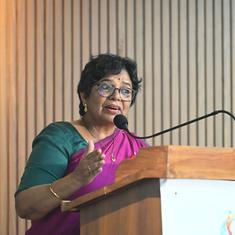Some compositions are inexorably associated with specific musicians, either due to the intrinsic beauty of the compositions that was brought to the fore by the latter for the first time or because of their superb elaborations of the original compositions that have been recorded for posterity and are still easily accessible. In such cases, interpretations of the same compositions by other musicians pale into insignificance.
Even so, musicians are inevitably drawn to these compositions and choose to present them, for a variety of reasons. For one, the initial iconic rendition may inspire them, or they could be prompted to do so because of the sense of nostalgia that such compositions evoke in audiences. Besides, there are occasions when some members in the audience or the concert organisers request performers to make such inclusions.
Whatever be the reason for later-day performers to present these compositions, it is always challenging for them to match the high benchmark that has been established by the original renditions. Some would even advise them to exercise caution and steer clear from hoping to achieve what would be considered an impossible task, as most renditions often try to imitate the original instead of trying to capture its essence. But the fact remains that notwithstanding the rare cautionary note there will always be efforts to the contrary.
A classic example of such compositions is the thumri Yaad Piya ki Aaye popularised by Bade Ghulam Ali Khan, the Patiala gharana exponent. Here is a link to the original commercial recording:
Despite the constraints on duration placed by the recording format of the time, this track encapsulates the maestro’s style of thumri singing.
A more detailed version is available on the next track that has been recorded in a live concert. Here, listeners will get a fuller picture of Bade Ghulam Ali Khan’s style. The sense of balance that he brings to the interpretation is palpable as he negotiates between passages that are restrained and those that involve swift intricate taans, or deviates from the main melody that is based on the raag Bhinna Shadaj. The taans, melodic deviations and sargam or solfège patterns, are not attempts at leaving the listeners wonderstruck. Their fluidity forms an organic part of the rendition in spite of their unpredictability. His enunciation of the words is delicate in keeping with the aesthetics of the thumri form. He includes a few couplets that are not part of the commercial recording.
We now move to a few examples of other renditions that have followed over the years.
This track features Ajoy Chakraborty, a well-known representative of the Patiala gharana.
Rashid Khan, popular vocalist of the Rampur-Sahaswan gharana, sings the same thumri. He is accompanied on tabla by Shubhankar Bannerjee, on the harmonium by Ajay Joglekar, and on the sarangi by Murad Ali.
There have been occasions when this thumri has been used outside conventional Hindustani music recitals. For instance, thumri exponent Shobha Gurtu sang it for a feature film entitled Prahaar.
Yaad Piya ki Aaye also seems to be a favourite with those involved in intercultural music experiments popularly known as fusion music. The Wadali brothers Puran Chand Wadali and Piyare Lal Wadali, known for their renditions of Punjabi Sufi poetry, sing the thumri accompanied by Indian and Western instruments.










